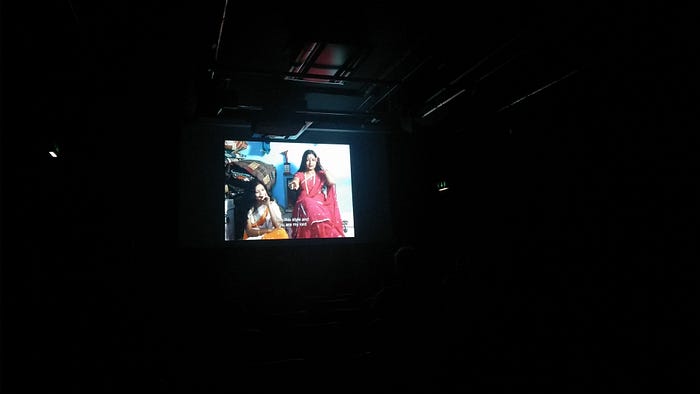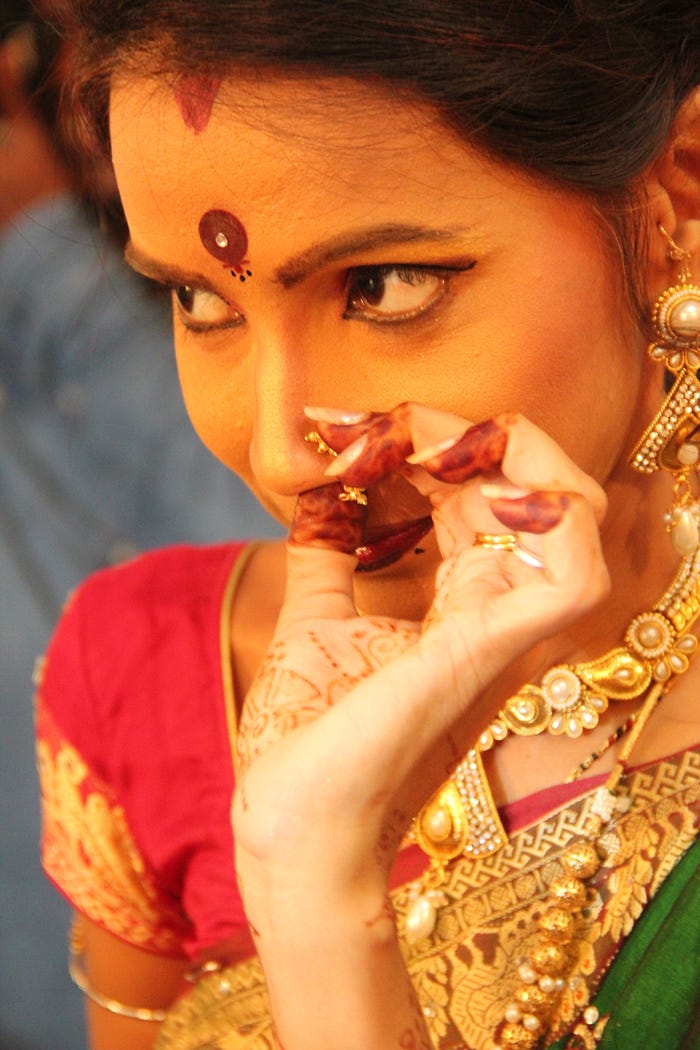Lessons from Lavani
What are the lessons we can learn from the urban revival of Lavani — a dance form from Maharashtra in Western India that often explores themes of female sexuality? Dr Lisa Björkman (University of Louisville) reports on a visit to UCL Urban Laboratory by Mumbai-based filmmaker and writer Savitri Medhatul and Bhushan Korgaonkar for a one-week festival celebrating and exploring Lavani organised by Dr Andrew Harris (UCL Geography).
Written by Dr Lisa Björkman

In their seminar as part of the “Lessons from Lavani” week of events at UCL, Savitri Medhatul and Bhushan Korgaonkar laid out the peculiar and intriguing puzzle that initially inspired them to turn their research attention to Lavani. Women who dance Lavani, they explained, tend to be characterized in either one of two ways: on the one hand, popular discourse portrays Lavani dancers as money-minded manipulators, instrumentally and unscrupulously enlisting the sensuality of their dance in seducing impressionable men and destroying respectable families. A second characterization, by contrast, has Lavani women themselves as exploited — victims of caste, class, and gender-inflected sociopolitical structures and age-old relations of marginalization, exclusion and oppression. Medhatul’s and Korgaonkar’s initial engagements with Lavani dancers, however readily revealed a much richer, dynamic and complex situation than what these moralizing binaries afford — a situation that their collective work reveals as infinitely more interesting.

UCL’s “Lessons from Lavani” festival kicked off with a screening of Medhatul’s 2008 documentary film Behind the Adorned Veil, in which the filmmaker trained her camera on a dance theatre in the Maharashtran city of Pune. The making of Behind the Adorned Veil marked the beginning of Medhatul and Korgaonkar’s collaboration with Lavani; it was in the process of working on the film that Korgaonkar began penning his own account, which culminated in his 2014 book Sangeet Bari. In the years that have followed, Medhatul and Korgaonkar have continued their work with Lavani dance theatre, and have produced a stage production in collaboration with the Pune-based dancers that feature in the film and book. Medhatul and Korgaonkar have recently taken their show on the road, performing it (in both Hindi and Marathi) in cities across India. The dance-art-activist initiative has been received with both tremendous enthusiasm and visceral discomfort, as their popular and provocative show unmasks and destabilizes received categories and social tropes through which Lavani is often described: traditional vs. modern; classical vs. folk; performer vs. audience and (perhaps most provocatively) exploiter vs. exploited. Indeed, Medhatul and Korgaonkar’s work unsettles the normative and sociological presumptions imbued in these categories, ruffling feathers, eliciting peals of laughter, and allowing other meanings and understandings to emerge.

But first, a few words on Lavani. Medhatul and Korgaonkar explained in their seminar that Lavani has become increasingly well-known throughout India due to its appearance in popular films (both Hindi and Marathi). Lavani gained worldwide renown in 1994 when Hindi film heroine Madhuri Dixit caught the attention of a young hero (played by Bollywood’s blue-eyed boy Shah Rukh Khan) in a Lavani-inspired number titled “Main Kohlapur Se Aayi Hoon” (I’m from Kohlapur) featuring in the Bollywood blockbuster Anjaam (Consequence). Recent years have seen the increasing popularity of “banner show” Lavani performances in urban settings — especially in Mumbai — where professionally trained dancers perform three-hour lavani shows to the accompaniment of live music, punctuated by comedy sketches. Film- and banner-show lavani performed in urban settings has roots in two other long-standing lavani forms: on the one hand, the rural traveling theatre known as Dholki Fadacha Tamasha and on the other, the urban Sangeet Bari theatres. Tamasha is a traveling folk theatre tradition common throughout rural Maharashtra. The traveling troupes are on the move for up to eight months per year, and are comprised of a variety of theatrical forms, song and dance traditions among which Lavani is a particularly loved element. Lavani in the context of tamasha, Medhatul and Korgaonkar explained, is performed on stage in front of large audiences. Tamashas can be either ticketed events or else — if sponsored by local wealthy families or business groups — free and open. When ticketed, the tickets are generally inexpensive, as the price is not meant to exclude people from watching but rather to pay for the event. Tamashas generally comprise a whole night of events, of which lavani dance performances are generally an important and particularly celebrated part. Banner show Lavani, by contrast is a relatively recent phenomena that takes place in closed performance spaces (theatres) in Mumbai and Pune. Banner shows are ticketed affairs where people come to watch Lavani performances that last around two or three hours. So whereas tamashas have lavani as one part of a longer event (with drama, and music and performances of various sorts), banner shows are all lavani.
Sangeet Bari (which translates roughly as “turn at the music”) refers to lavani that is performed at a “Sanskrutik kala kendra” — or “cultural arts center” — residential complexes located on the outskirts of many smaller cities and towns throughout Maharashtra; dancers who perform sangeet bari live at the theatre. As documentary filmmaker Medhatul explains, “sangeet bari is a lifestyle and life choice — unlike a like a banner show where they perform for two hours and then ‘go back’ to their other lives” (2008). In Medhatul’s 2008 documentary film Behind the Adorned Veil, Sangeet bari dancers report that their mothers and grandmothers were also sangeet bari dancers — that they “belong” to sangeet bari by caste and community. Pursuing sangeet bari as a “life choice,” Medhatul’s film reveals, means moving into the Kala Kendra and generally implies foreswearing marriage. While Sangeet Bari dancers may have long-term monogamous relationships with “customers” over their lifetimes, they continue to reside in the sangeet bari, where they sleep, cook, eat and raise children, practice and train in both lavani and in Hindi film choreography, for which dancers report their customers often make requests. Sangeet bari dancers, in other words, are in a way not performing when they dance lavani; rather, they’re dancing as sangeet bari dancers.

There are thus a few key differences between the dancer-audience relationship in Sangeet Bari and that relationship when the lavani is performed as part of either a tamasha or a banner show. First, a tamasha performer of lavani is part of a traveling show, so even if the dance for itself is interactive with the audience — often outrageously and hilariously bawdy and suggestive, meant to elicit response from the public who are thus enlisted in the into lavani itself. Lavani dancers explain that the distinctive feature of their art is in the eye contact that they maintain with the audience — drawing them into the performance itself. Dancers claim that a particular challenge of the banner show is that the stage lights in contemporary theatres are so bright that it’s hard to maintain eye contact (Medhatul 2008). As one lavani dancer who features in Korgaonkar’s book describes, “In lavani, the expressions and adakari [performance] are very important. A lavani performance should be such that every person in the audience should feel that this woman dancing in front of me is performing for me alone only. There should be a connection[1] like that between the audience and the performer. Only then do I consider it to be a true lavani Performance” (Korgaonkar 2014: 9–10). Indeed, Korgaonkar describes his first encounter with the dance in similar terms. “I don’t remember clearly what happened in the next twenty minutes on stage,” Korgaonkar recalls; “I was lost completely. [The dancer] met my eyes as she performed her turns. I started to feel that this play was only for me” (Korgaonkar 2014: 8).
[1] She used the English word “connection.”

Earlier in the “Lessons from Lavani” week at UCL, Medhatul and Korgaonkar introduced a group of ten UCL students and faculty to the rhythms, turns, and eye-contact arts of Lavani. The dance workshop (in which I too took part) was animated by the lavani song “Lahi Lahi Hote Majhya Angachi” (I’m Burning Up). Medhatul choreographed a lavani for the group, first dancing the lavani for the group and then leading us step-by-step — smile-by-flirtatious-smile — through the steps:
Can’t you see the blood rising, hectic through my face, as I sit dressed up in my Kohlapuri necklace
Drawing on the group’s embodied engagement with the dance, Medhatul and Korgaonkar related stories about the workshops they have conducted across India. During the workshops, which span three days, Bhushan and Mehadul teach and choreograph one Lavani song, screen the documentary film, and conduct open discussions. Medhatul explains that when encountering lavani for the first time “many housewives become very emotional. They find the whole idea liberating — they love the costumes and the makeup and especially the seduction part.” Korgaonkar recalled how the idea to take the show on the road was borne of the intensity of such encounters during their inaugural performance in Pune:
The show was a great success but what happened after the show was more significant. Some girls from a theatre group came backstage to meet Mohanabai [the lead dancer]. The girls told Mohanabai how they were mesmerized by her performance and they touched her feet. Mohanabai became very emotional and told us that in the past many people have expressed appreciation for her lavani by giving her money, gifts and so on, but today for the first time someone has touched her feet — which is the highest gesture of respect any artist could hope for.
It was at this time, Medhatul explained at our London seminar, that she and Korgaonkar realized the power and significance of bringing lavani out of sequestered and somewhat-stigmatized city spaces of Sangeet Bari theatres, and to produce a show for the broader urban public. Their production appeals to a wide audience comprised of women as well as men, and has a growing fan base that crosses class, caste and community lines. Medhatul and Korgaonkar explain that they never imagined — when they first set out to make a documentary film about Sangeet Bari lavani — that the project work might inspire this kind of critical social engagement and energy. But as their traveling Sangeet Bari show gains popularity and their calendar of bookings overflows, so too do the artists’ aspirations that the dynamism and creativity of lavani might inspire the reworking and rethinking of moralising norms and taken-for-granted sociopolitical hierarchies and categories that Lavani so readily troubles. And those of us who were fortunate enough to participate in UCL Urban Lab’s “Lessons From Lavani” workshop with Medhatul and Korgaonkar will also be waiting eagerly to discover what lavani’s growing popularity inspires.
With thanks to the UCL Grand Challenge of Cultural Understanding and UCL Urban Laboratory for supporting the “Lessons from Lavani” week, and to the Bloomsbury Theatre Studio for hosting the film screening and dance workshop. To follow Savitri Medhatul’s and Bhushan Korgaonkar’s work please follow their Facebook page or contact savitrimedhatul@gmail.com

Further resources:
Korgaonkar, Bhushan (2014) Sangeet Bari. Mumbai: Rajhans Prakashan.
Medhatul, Savitri (director) (2008) ‘Natale Tumchaasaathi — Behind The Adorned Veil’ (documentary film).
